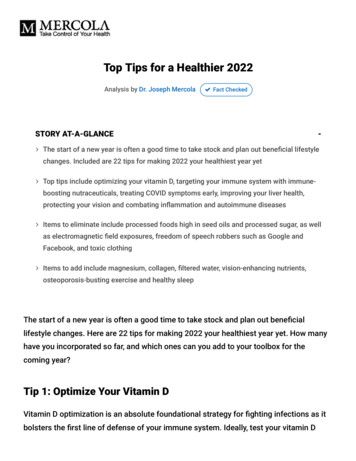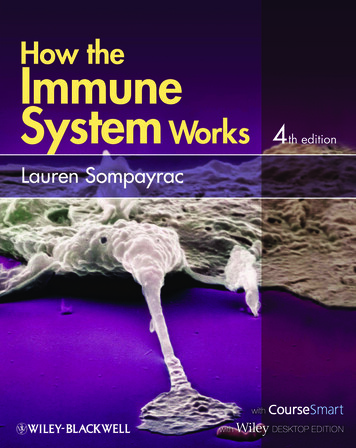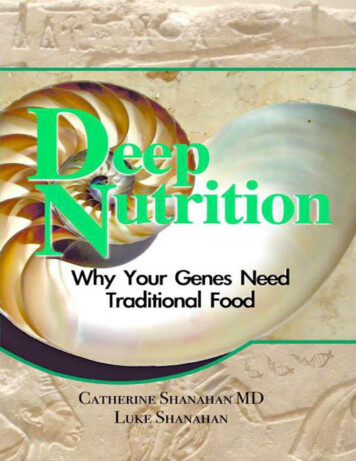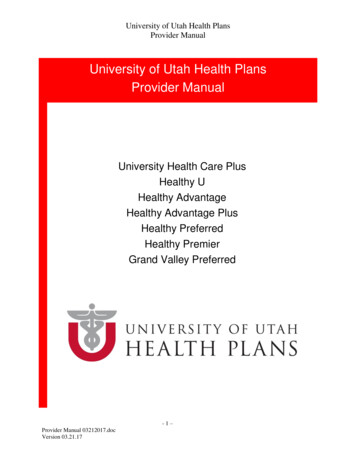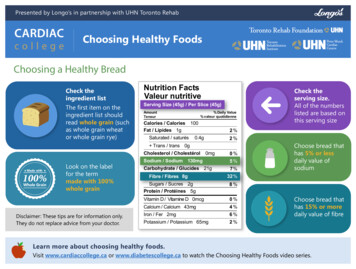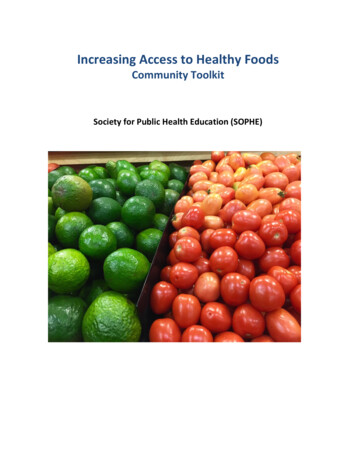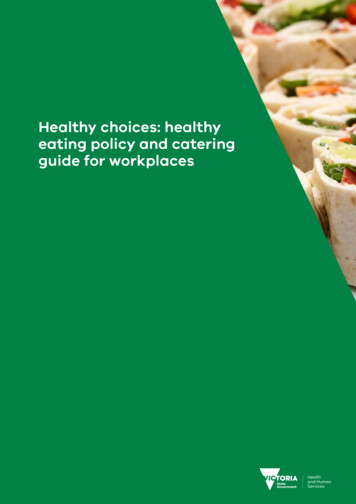
Transcription
Staying Healthy with ImmuneBoosting & Anti-inflammatoryFoodsKate Ueland MS, RD
Objectives for Talk Describe a healthy immune system Define the immune response Explore the major nutrients that support a healthy immune system Explore the minerals that support a healthy immune system Explore herbs and spices that support a healthy immune system Putting it all together to support a healthy immune system Recipes to support a healthy immune system
The Importance of a Healthy Immune System The immune system is responsible forfighting foreign invaders in the body,like pathogenic bacteria and viruses,and also destroy cells within the bodywhen they become cancerous. Poor nutrition results in increased infections, slow healing frominjury and infections, and increases susceptibility to symptoms andcomplications from immune system dysfunction. Studies shows that immune function often decreases with age, andrecent research suggests this decrease is also related to nutritionand may be slowed or even stopped by maintaining healthynutrition.
What is the immune system?The ability tofight infection,illness, anddiseaseImmune Systemhas two lines ofdefense e)immunity4
What is the immune system?What is Specific about it? It’s all about “FlyingFlags”Antigen and AntibodiesAntigen foreign protein (of virus/bacteria/cell)Antibody receptor for foreign protein (”Eat Me Flag” formacrophages.
Lines ofDefenseInnateimmunity:7 lines ofdefenseAdaptiveimmunity: Band T cells
Gastrointestinal Barrier and the Immune System The gastrointestinal tract has approximately 150 x more surfacearea than your skin. It contains the largest number of immune cells of your whole body,constituting approximately 60% of your entire immune system. It comes into contact with the largest amount and number ofdifferent molecules and organisms of any organ in your whole body. Regulates the absorption of nutrients while keeping out damagingmolecules and pathogenic organisms.
Protein and the Immune System Studies have shown that deficiency of high-quality protein canresult in depletion of immune cells, inability of the body to makeantibodies, and other immune-related problems. High-quality, complete proteins are found from many sources: eggs, fish, and shellfish, tofu, tempeh and quinoa Many vegetables and grains are also excellent sources of many ofthe immune-stimulating amino acids Broccoli, brown rice, nut butters, mushrooms, nuts and seeds
Omega-3 Fatty Acids and the Immune System Diets low in omega-3 fatty acids are associated with chronicinflammatory conditions and autoimmune diseases. In order to achieve a more beneficial ratio of omega-3 fatty acids inyour body, it is important to decrease the amount of omega-6 fattyacids in your diet, while increasing the amount of omega-3 fattyacids. Reduce your consumption of conventionally raised meats and dairyproducts, and refined foods Increase consumption of wild-caught cold-water fish like salmon,tuna, mackerel and sardines, ground flaxseeds, walnuts, pumpkinseeds leafy green vegetables, and grass fed meats and dairy.
Fiber and the Immune System Whole, fresh fruits and vegetables,promote a healthy gastrointestinalsystem. They are fermented by the friendlybacteria in your colon to short-chain fatty acids (SCFAs), which areused as a fuel by gastrointestinal tract cells. Fiber also promotes the removal of toxins that can adversely affectyour gastrointestinal tract cells and supports healthy digestivefunction overall.
B vitamins for a Healthy Immune System Vitamin B5 (pantothenic acid) promotes the production and releaseof antibodies from B-cells, and deficiency of vitamin B5 results inreduced levels of circulating antibodies. Folic Acid deficiency leads to a decrease in T-cells and supportsproduction of red blood cells which carry oxygen around the body. Vitamin B6 deficiency consistently impairs T-cell functioning andresults in a decrease in blood lymphocyte counts. Vitamins B1 (thiamin) and B2 (riboflavin) are important in normalantibody response. Vitamin B12 appears to inhibit phagocytic cells and possibly T-cellfunction.
Excellent Sources of B Vitamins Whole grains, vegetables and fruits can serve as excellent sources ofat least some of these vitamins in particular, Romaine lettuce is a rich source of vitamins B1, B2,C, and folate. Spinach is an excellent source of folate, vitamin B6 and vitamin C. Cauliflower is an excellent source of vitamin C, folate, vitamin B6,and pantothenic acid. Crimini mushrooms are an excellent source of vitamin B2, niacin,and pantothenic acid. Red bell peppers are an excellent source of vitamin B6. Excellent sources of vitamin B12 include sardines, salmon, tuna,cod, lamb, scallops, shrimp, and beef.
Vitamin C for a Healthy Immune System Supports a decrease in the length of time and severity of symptomsassociated with upper respiratory viral infections, promotephagocytic cell functions, and support healthy T-cell function. Provides antioxidant activity to support healing at sites ofinflammation.
Excellent Sources of Vitamin C Citrus fruitBroccoliKaleBok choyBeet greensCollard greensSwiss chardAsparagus
Vitamins A, E, K for a Healthy Immune System Vitamin A deficiency has been shown to impair antibody functionand T-cell activity. Vitamin E is an important antioxidant and supports a healthyinflammatory response. A important component of all cellmembranes and promotes healthy cellular functioning overall. Vitamin K supports a healthy blood-clotting ability in your body, andthis is necessary for seclusion of areas of infections and injury in thehealing process.
Excellent Sources for Vitamins - A, E, KVitamins A & EVitamin K Turnip greens Swiss chard, and mustardgreens Pro-vitamin A carotenoids Cauliflower Green vegetables such asspinach and asparagus.––––––Leafy greensCarrotsSweet potatoesWinter squashAsparagusBok choy
Zinc for a Healthy Immune System Deficiency can result in profound suppression of T-cell function. However, an excess of zinc has also shown negative effects onimmune function and can inhibit the phagocytic cells(macrophages and neutrophils) maintaining adequate but not excessive levels of zinc isimportant. This is one reason food is such an excellent source of obtainingnutrition versus supplementationFood contains a balanced variety of micronutrients whereassupplementation with individual nutrients can lead to too much ofsome and not enough of others.
Excellent Sources of Zinc SpinachAsparagusShiitake mushrooms and crimini mushroomsSesame seedsPumpkin seedsGarbanzo beansLentilsCashewsQuinoa
Minerals to Support Immune System Copper deficiency is associated with an increase in infections andmay impair development of immune cells such as T-cells and thephagocytic cells Iron deficiency results in impaired response to antibodies, anddefective phagocytic cell functioning.
Excellent Sources of Copper and IronCopperIronSesame seedsCashewsSoybeansMushroomsBeet greensSpinachAsparagusSwiss chard, mustard greens,kale Summer squash SpinachSwiss chardCuminTurmericBeet greensCollard greensBok choyAsparagusLeeksRomaine lettuce
Herbs to Support Immune System Cinnamon Anti-inflammatory – stimulates the production of digestiveenzymes Cinnamaldehyde an active compound reduces inflammation, inaddition cinnamon contains salicylate (found in aspirin) whichreduces pain and promotes heart health by helping to preventblood clots Garlic Anti-inflammatory – contains a number of sulfur compounds,including allicin, that helps to prevent free radical damage tolinings of blood vessels, limiting inflammation.
Herbs to Support Immune System Ginger Anti-inflammatory Known as a digestive aid to soothe tummy aches Turmeric Anti-inflammatory Anticancer May limit the impact of upper GI diseases such as Irritablebowel syndrome
Are there foods that are bad for the immune system? Processed foods may be problematic for your immune function. Toxic metals such as cadmium, lead and mercury areimmunosuppressive. Food additives can also have untowardeffects on the nutrient content of thefood. Some preservatives can negativelyeffect the gastrointestinal lining. Trans fats Studies have shown that consumption of trans fats are proinflammatory, leading to chronic diseases such as cardiovasculardisease (CVD) and type 2 diabetes. 2% increase in energy intake from trans fats was associated with a25% increased risk of CVD and 31% increase in CVD mortality.
How to Support a Healthy Immune System Consume adequate protein and healthy fats. Maintain a healthy balance between omega-3 and omega-6 fattyacids. Studies indicates a ratio of omega-3 to omega-6 fats of 1:4 ishealth-promoting. Provide micronutrients and phytonutrients that support healthyimmune function. Decrease intake of allergens and toxins. Maintain healthy weight and cholesterol levels. Basing your diet on nutrient-dense foods, is one way to decreasecalorie consumption while consuming optimal levels ofmicronutrients and immune-supporting phytonutrients. Eat the Rainbow of Color!!!
Recipes
The Emerald City SaladThis salad has many immune boosting vegetables and herbs and spices. It is filled with color andis a great addition to any holiday party.Prep Time: 1 hour and 15 minutesMakes 6 to 8 servings2 ½ cups water or stock1 tablespoon butter1 teaspoon salt, divided1 cup wild rice (black, ½ - inch long)¼ cup lemon juice¼ cup olive oil1 clove garlic, minced½ cup chopped fennel bulb, core removed½ red or yellow pepper, diced½ cup chopped red cabbage½ cup chopped Italian parsley2 cups very finely chopped dark, leafy greens (6to 7 leaves of chard, kale, or collards)Salt and lemon to tastePecorino or Gorgonzola cheese, for garnish(optional)Bring water to a boil. Add butter, ½ teaspoon of the salt, and rice. Bring to a boil again, cover,lower heat, and simmer 60 to 65 minutes. Make sure all of the water is absorbed by tipping thepan to one side to check for pooled liquid.Combine lemon juice, olive oil, garlic, and remaining ½ teaspoon of salt in a large serving bowl.Add fennel, red pepper, cabbage, parsley, and greens and toss thoroughly.Once the rice is fully cooked, cool until it ceases steaming but is still warm, then place it on top ofthe dressed vegetables. When the rice cools to room temperature, toss it with the vegetables.Taste the salad and adjust seasonings; some extra salt and/or lemon may be required. Garnishwith cheese, if desiredAdapted from Feeding the Whole Family by Cynthia Lair
Quinoa with Edamame, Ginger and LimeHigh quality protein from quinoa and edamame help to support a healthy immune system while ginger is a strong antiinflammatory herb and lime is rich in vitamin C. Together this dish is rich in protein and phytonutrients and will be agreat addition to any holiday meal.Prep Time: 15 minutes Cook Time: 20 minutesMakes 6 servings2 ½ cups broth½ teaspoon salt1 ½ cups red or white quinoa, rinsed well in cold waterand drained1 teaspoon grated fresh gingerPinch of cayenne1 cup fresh or frozen edamame, mixed with a spritz oflime juice and a pinch of salt½ cup finely diced red bell pepper2 scallions, white and green parts, finely chopped2 tablespoons chopped fresh mint2 tablespoons chopped fresh cilantro, basil orparsley2 tablespoons olive oil2 tablespoons freshly squeezed lemon juice2 tablespoons freshly squeezed lime juice1 tablespoon freshly grated lemon zest1 tablespoon grated lime zestPut the broth and ¼ teaspoon of the salt in a large saucepan and bring to a boil over high heat. Stir inthe quinoa. Decrease the heat to low, cover, and cook for 15 to 20 minutes, until the water isabsorbed.Remove from the heat. Add the ginger, cayenne, and remaining ¼ teaspoon of salt and fluff with afork until well combined. Transfer the quinoa to a bowl and let cool to room temperature.Add the edamame, red bell pepper, scallions, mint, cilantro, olive oil, lemon juice, lime juice, lemonzest, and lime zest and stir until well combined. If needed add a pinch or two of salt, a squeeze oflemon or lime juice, or a dash of olive oil.Adapted from The Longevity Kitchen by Rebecca Katz
Golden Roasted CauliflowerCauliflower is part of the cruciferous vegetable family and is known for its anticancer properties.This combined with turmeric, a well known anti-inflammatory spice is well suited for any holidaymeal. The golden color from the turmeric will make guests feel the warmth of the season.Prep Time: 10 minutes Cook Time: 35 minutesMakes 4 servings2 ½ to 3 pounds cauliflower, cutinto 1 ½ - inch florets2 tablespoons olive oil1 tablespoon minced garlic½ teaspoon salt½ teaspoon turmeric½ teaspoon ground cumin¼ teaspoon ground coriander¼ teaspoon freshly ground blackpepper1 teaspoon freshly squeezedlemon juice1 tablespoon finely chopped freshparsley or cilantroPosition a rack in the middle of the oven andpreheat the oven to 425oF. Line a rimmed bakingsheet with parchment paper.Put the cauliflower, olive oil, garlic, salt, turmeric,cumin, coriander, and pepper in a large bowl andtoss until the cauliflower is evenly coated. Transferto the lined baking sheet and spread in an evenlayer. Bake for 25-35 minutes, until the caulifloweris golden and tender. Transfer to a bowl, add thelemon juice and parsley, and toss to combine.Adapted from The Longevity Kitchen by Rebecca Katz
Spiced Almond Macaroon ButtonsAdapted from The Longevity Kitchen by Rebecca KatzThis version of the French macaron will surely delight guests with a variety of pallets. This versionuses cinnamon a well known anti-inflammatory spice along with other soothing spices and someprotein from the almonds.Prep Time: 15 minutes Cook Time: 15 minutesMakes 20 macaroonsPreheat the oven to 350oF. Line a baking sheet with parchmentpaper.1 cup almond flour3 tablespoons turbinadoPut the almond flour, sugar, cinnamon, allspice, cardamom, and saltsugarin a bowl and stir to combine.¼ teaspoon groundcinnamonPut the egg whites in a small bowl and beat lightly with a fork to1/8 teaspoon groundmake them easier to measure and pour. Add 3 tablespoons of theallspiceegg whites, the almond extract, and the vanilla to the almondPinch of groundmixture and stir with a spatula. The texture should be wet and soft,cardamombut stiff enough to form into a ball between wet hands. If the dough1/8 teaspoon sea saltfeels too stiff, add a bit more egg white.¼ cup egg whites (about 2large eggs)Using wet palms and fingers, roll a scant teaspoonful of the dough¾ teaspoon almondinto balls. Put them on the baking sheet, spacing them about 2extractinches apart, and flatten slightly with damp finger. Press an almond¼ teaspoon vanilla extractor a few slivered almonds onto the top of each cookie. Bake for20 whole almonds, or 1about 15 minutes, until the tops are dry and a very pale goldencup slivered almonds, forbrown. Peek at the bottoms; they should be a golden brown.decorationImmediately transfer to a wire rack and let cool before serving.
Questions?Thanks for your time today!I hope you have a safe and happy holidayseason!
ImagesHealthy gut: 9/gut-bacteria.jpgTofu: X-HyWyy4 /800x600/filters:no fu.jpgEggs: -EGGS-VS-WHITE-EGGS-facebook.jpgLegumes: https://i.ytimg.com/vi/WDV4rUN-O 4/maxresdefault.jpgFlaxseeds: axseed/Brown-Flax-Seeds-Main.jpgSalmon: 27136e95/5/6/563048327953896754.jpgFiber: er-foods-2.jpgRed bell pepper: Broccoli: l-About-Broccoli-resized.jpgFruit Poster: .jpgWinter squash: rrots: 6.jpgPumpkin Seeds: 2017/08/pumpkin-seeds-with-folate.jpgCashews: http://v1.myevolve.co.uk/ includes/images/uploads/Kenkko/istockphoto 6290659-cashew-nuts.jpgKale: shrooms: ms-guide-700-350.jpgAsparagus: 1033249144001/201512/1736/1033249144001 4652165666001 4609820823001vs.jpg?pubId 1033249144001Cinnamon: uct images/uploaded images/cinnamon-sticks.jpgGarlic: arlic-Background.jpgGinger: ds/2016/02/ginger-600x399.jpgTumeric: -two-simple-ingredients.jpgProcessed foods: .jpg
Anti-inflammatory – stimulates the production of digestive enzymes Cinnamaldehyde an active compound reduces inflammation, in addition cinnamon contains salicylate (found in aspirin) which reduces pain and promotes heart health by helping to prevent blood clots Garlic Anti

